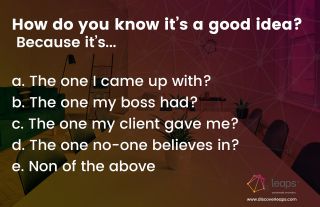Lining the trash bins of wastepaper and email are hundreds of thousands of ideas.
Many are no doubt fantastic, and could have boosted creativity, business and impact. Others have been scrapped for good reason – often way too late, but that’s another post – and their implementation could have been detrimental to business and creative outcomes. Evaluating ideas is difficult work. Review processes are often unevenly implemented, inertia can stifle truly creative ideas, and gems can get lost to bureaucracy.
The consequences of poor idea selection and management are real.
When ideas are not correctly managed, this can dampen the enthusiasm and kill innovation culture. Individuals may start to feel that their voices are not valued or heard, and they may begin to withdraw.
As a result, the positive environment that fostered active idea generation can begin to stagnate. All in all, not having a system in place with which to handle new ideas can be destructive to innovation, breakthroughs and creativity goals.
At Leaps™, we strongly believe in the power of building a fast-track early stage screening process, as an integral part of the innovation life-cycle. Mere idea generation is not sufficient for true innovation, it also requires a system by which ideas are filtered for action, testing, pivoting and next steps.
The function of any early screening process is to quickly and efficiently weed out those ideas and innovations that do not meet your defined selection criteria.
This would then enable ideas to progress to the important stage of testing and validating learning phases. It is important that the screening process doesn’t become over-complicated at this point, and that it’s quick enough to be sustainable for busy teams.
There are many existing models and techniques out there and you might have tried a few from:
- V-SAFE Screening (Source innovation management)
- FAN
- TESCO 3 Q’s
Let’s take a quick look at each of these:
V-SAFE screening (Source innovation management)
VALUE
SUITABLE
ACCEPTABLE
FEASIBLE
ENDURING
To me this fails on a fundamental level, in terms of a the negative cognitive bias, by where you are priming the evaluation to steer away from bold, risky and game changing by its very name V-SAFE! This feels like it comes from a scarcity and fear based mindset. We should be inspiring the exact opposite.
FAN
Paul Sloan an innovation specialist recommends a general set of criteria for all sorts of ideas, the FAN method. Are you a FAN of the idea? Example:
Is it Feasible?
Is it Attractive?
Is it Novel?
This is better, and a good starting point, but for me falls short of the level of rigor required to align ideas to strategy, market trends, growth and, frankly, betterment!
Tesco 3 Q’s, uses the following criteria for selecting ideas:
Is it better? (For customers) Is it simpler? (For staff) Is it cheaper? (For Tesco)
Nice, I like this. Straight forward, I can understand it and easily apply. However, we think there is a better, more effective model and it’s one we have created.
The model we developed and now use with a number of clients is defined by the acronym BIG IDEAS™. In this system, each idea is mapped against eight different categories: Better, Investment, Growing, In-line, Deliverable, Enduring, Attractive, Sellable.
By the very nature of the word, this inspires ambition.
To think abundantly and go for a moonshot.
Just what we like to champion.
B-BETTER
For customers
I-INVESTMENT
The level of investment required and the internal appetite for this. Can the innovation be managed within existing budgets or will additional funding be required?
G-GROWING
Aligned to an attractive and significant future market trend/growth? What is the net contribution to current business imperatives?
I-IN-LINE
With our strategy and brand space. This weeds out potential ‘distractions,’ which are always a risk when looking at innovations.
D-DELIVERABLE
Accessible resources; is there existing knowledge? Are there clear routes to market? Do we have the ability to commission an M.V.P within the desired timelines?
E-ENDURING
Will the idea deliver value in both the long and short-term? If a new idea or innovation is to be truly strategic, it should survive the rigours of time. Is the long-term gain worth the short-term pain of bringing a new idea to fruition? Again, this highlights the potential return on the investment to be made.
A-ATTRACTIVE
The level of stakeholder excitement and ability to champion throughout the team. Often ideas fail because of the ‘not invented here’ syndrome or office politics. It is crucial that proponents of an idea spend time and effort on selling the idea internally and gauging the level of support for it.
S-SELLABLE
Is it easy for customers to understand and will customers buy into the proposition, with good profit margins? Does the idea deliver tangible benefits to the organisation?
Two key elements are the weighting and establishing a cohesive method for the scoring of the 8 categories.
Depending on your resources, phase and goals of your organisation or team, we suggest weighing each category in order to make sure the screening process matches the company objectives.
To effectively use any screening process like BIG IDEAS™, it has to be easily understood by all who submit ideas, publicised for all to see, standardised as a template and never short-circuited without good reason! Ideas should always be viewed within context and not in isolation, as prioritising ideas and innovations is all about relative merit in the battle for resources and time. Agreement to any given methodology will add value to, build deeper ownership of, and cause the recurrence of good ideas across the organisation.
Innovation happens all the time. Individuals will always raise ideas for continual improvement or betterment.
Why not use a standard process across the board in order to capture, evaluate, and implement the best ideas?
This does not belong in the pocket of a siloed innovation department, but is integral to the entire business. Instead, when the process is embedded into the culture of an entire organisation, it can foster deeper commitment to values and goals. People will begin to understand why their ideas were adopted, or why they were not, and will be able to use that as a jumping-off point for their next idea.
Communication of the evaluation process and the impact, results, failures and impact is also a critical element of innovation. Having an ‘open-loop’ feedback system completes the cycle at the back-end of idea implementation.
You can perpetuate confidence throughout your organization by implementing a process like BIG IDEAS™. Get in touch with us to learn more about how we can help facilitate accelerated innovation for your team or organisation!
P.S. If you would like a copy of the BIG IDEAS™ evaluation template and methodology please email us and we will send one out to you.


